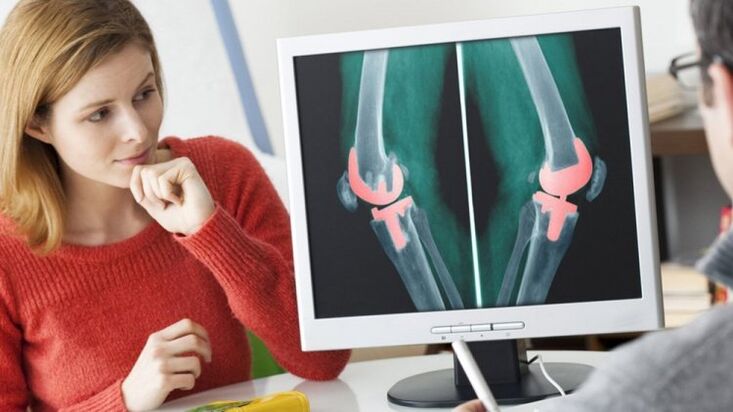Arthritis is the most common joint damage in medical practice, associated with degenerative-dystrophic processes occurring in them. The main cause is that the body is aging and the joint tissues are destroyed, so the disease cannot be completely cured. However, according to experts, it is within a person's ability to slow down the destruction process, delay the degenerative process of joints and maintain long-term joint health.
Arthritis and its symptoms

The destruction of joints begins with the gradual wear and tear of cartilage - the main element of this movable connection of bones, which protects them at the point of contact from friction and acts as a shock absorber under pressure. mechanics. In most cases, this process is due to the decline in metabolism in the human body with age and malnutrition of the joints. Therefore, the symptoms of the disease usually appear after 40 - 50 years. However, the development of negative changes in cartilage tissue occurs at an earlier age and includes a gradual loss of cartilage elasticity, thinning, and destruction.
The inability of cartilage to fulfill its functions causes negative changes in the bone tissue, which can grow, forming osteoblasts (growing in the form of tubercles, spines, hook), is a source of pain during movement. Gradually, the pathological process covers the muscles of joints, ligaments, tendons. Joints may be deformed.
The following symptoms indicate the development of joint disease:
- pain increases with movement and exertion;
- reduced joint mobility;
- swelling and inflammation (in some cases);
- deformity and immobility of the joint (in severe disease).
Osteoarthritis mainly affects the knees, hips, low back and cervical spine and hands.
Causes of disease and risk factors
The main reasons that lead to the destruction of joint cartilage and the development of joint disease include:
- genetic predisposition;
- joint injury, which can be mild, but repeated and repeated, or one-time but severe (eg, meniscus damage);
- Age-related changes in cartilage and bone tissue.
There are factors that increase the likelihood of developing joint disease. The main causes are excess weight, which increases the load on the joints and a sedentary lifestyle, interferes with the normal supply of blood and nutrition to the joints, impairs metabolism in them. Excessive physical activity, local inflammation, hormonal changes (eg, menopause) can also cause dry joints.
Treatment or prevention?

It is not possible to completely cure this disease - this is the common opinion of rheumatologists, whose mission is to combat joint disease. Modern therapy can slow cartilage destruction, reduce inflammation, relieve pain, and improve a patient's condition. For this purpose, in the treatment of joint diseases, they use:
- chondroprotectors based on chondroitin sulfate and glucosamine;
- non-steroidal anti-inflammatory drugs;
- intra-articular injection of hyaluronic acid or hormonal drugs;
- physiotherapeutic procedures (ultrasound, electrophoresis, laser and magnetic therapy, application of mud);
- physical therapy exercises.
In severe cases, they have to resort to surgery and replace the joint with a prosthetic leg.
With the main task of fighting the disease, modern medicine considers the prevention of joint disease and the promotion of a lifestyle that contributes to the preservation of joint health. This applies first of all to adolescents and young adults actively participating in sports where it is necessary to develop special skills to protect joints during exercise (warm-up and warm-up). , use special protective equipment: knee pads, elbow pads, etc. ). For people who don't participate in sports, the main ways to prevent joint disease are maintaining a normal weight and being physically active.
Weight loss and nutrition

As a result of many studies, it has been found that obese people have a 3-fold increased risk of joint disease. This is explained not only because excess weight increases the load on the joints, but also because excess fat stimulates the development of many pathological processes in the body that lead to serious diseases such as type diabetes. 2 and cardiovascular disorders, which negatively affect the condition of the joints.
Nutrition for the prevention of joint diseases is aimed at providing the body with nutrients necessary for the normal functioning of joint cartilage, slowing down the degenerative process in it. Adhering to the following basic principles will not only help keep joints in good shape, but also prevent excessive weight gain:
- reduce the calorie content of feed by eliminating or limiting fatty meats and poultry;
- eat adequate amounts of low-fat dairy products to provide calcium for bones;
- increase the proportion of grains, vegetables and fruits to supplement vitamins and trace elements to the body that joints need.
In the process of nutrition, special attention should be paid to foods and dishes containing natural substances that protect and strengthen cartilage tissue. These substances, first of all, include collagen - a protein that is part of the cartilage, ligaments and skin of animals and fish. To achieve this, it is necessary to include meat jelly, aspic (especially from fish), fruit jelly and other dishes containing gelatin, a type of denatured collagen, in the diet.
Physical activity to prevent arthritis

A sedentary lifestyle is one of the main enemies of human health, including the musculoskeletal system. While physical activity allows you to simultaneously achieve many of the goals needed to maintain joints and joint health:
- improve blood circulation and tissue nutrition;
- normalizes metabolism and prevents excess weight gain;
- muscle development, thereby strengthening the skeletal system;
- train all body systems and improve immunity;
- Improve mood.
To keep your joints in good shape, they shouldn't be overworked. But this doesn't mean you should give up physical activity. Movement is absolutely necessary for bones and joints, but it needs to be moderate, suitable for the physical, age and other unique characteristics of each person.
Experts say that walking is the best prevention of knee osteoarthritis at any age, and they recommend walking at least 6, 000 steps a day. Swimming is very beneficial, as the movement occurs in the absence of adverse effects on the bones of the body weight. Participating in any favorite sport or activity that involves movement (dancing, gardening, outdoor games with kids), as long as they are regular, will help prevent joint disease and keep you healthy. joints in good condition for a long time.

























